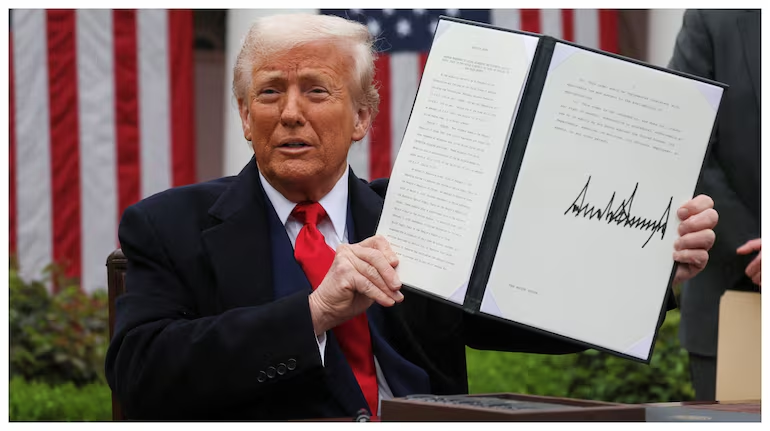27% tariffs were levied on India as part of Trump’s reciprocal plan, lowest amongst its Asian peers. The government intends to negotiate further and reduce tariffs for US imports into India under section 4 C of the executive order.

Donald Trump called April 2 ‘Liberation Day’ and promised economic benefits from his tariff policies.
India has been slapped with 27% tariffs as part of US President Donald Trump’s reciprocal tariff plan announced on April 2. He called April 2 “Liberation Day” and promised economic benefits from his tariff policies.
Interestingly, tariffs levied on India are the lowest amongst its Asian peers. 36 per cent tariffs have been levied on Thailand, 32% on Indonesia , 46 per cent on Vietnam, 34 per cent on China. The tariffs on China are in addition to the 20 per cent duties levied on the country days after Trump took charge. Compared to its Asian peers, India finds itself in a relatively better position, “ we are right in the middle, it shows that we have been negotiating right,” says a source privy to the negotiations.
The Commerce Ministry which has been in a huddle since early morning, right after Trump unveiled his reciprocal tariffs, is of the view that India will have to negotiate its way out and not retaliate. At the same time, officials are also mindful that it cannot be business as usual where tariffs are concerned. “India will cut tariffs across and the quantum of the cut will be significant,” said another source. In the anvil are cuts on duties on almonds, berries etc.
India is likely to negotiate under section 4 C of the executive order. Section 4 B has penalties for retaliation while section 4C permits reduction of tariffs on economic and national security matters.
Section 4C of Trump’s executive order stated, “Should any trading partner take significant steps to remedy non-reciprocal trade arrangements and align sufficiently with the United States on economic and national security matters, I may further modify the HTSUS to decrease or limit in scope the duties imposed under this order.”
This clause gives countries an opportunity to negotiate exemptions or reductions in the tariffs by addressing concerns raised by the United States.
According to sources, India will have to act fast, because countries like Vietnam could also take the same path. With 46 per cent tariffs on Vietnam, which Trump recognised as a ‘ transit economy’, these tariffs could be a severe blow for the country’s economy. So India will not be the only country to be trying for negotiations under section 4C. India is of the view that retaliatory tariffs and going the Canada way could be more damaging.
“I feel positive that we will come out of this, India can get itself out if it is really savvy and acts fast..so far our track record is better. India is better placed than other countries,” says a source who has been in touch with the negotiators.
Even as India is likely to negotiate for tariffs to be reduced, companies will have to brace up for higher costs
It’s won’t be all golden for President Trump either who will face economic and geo political challenges arising from these tariffs. The US equity markets are likely to take a hit as raw materials costs go up and offshoring becomes a challenge. The US companies that have built their models around the pillars of offshoring and cheaper inputs and have invested in massive supply chains are not likely to be too cheerful about the plan spelt out by Mr Trump to make America great again. Governments across the world are also not happy with the move and have said so in unflinching terms. “It’s like pushing your allies in the arms of your enemies,” says a source.
Hours after Trump unveiled his plan, European Commission Chief Ursula Von Der Leyen said, “Trump’s decision to impose new tariffs on all goods entering the US is a major blow to the world economy… the new tax imports will see uncertainty spiral, causing dire consequences for millions of people around the world.”
She has warned that the EU, which will be subjected to a 20% tariff, is preparing countermeasures in case negotiations fall. China, Japan and South Korea have also said that they will jointly respond to US tariffs.
What’s working for India is the camaraderie that the leaders of both countries enjoy. President Trump referred to the Indian Prime Minister as his friend even as there were concerns raised about India’s high tariffs. So far, the two sides have met twice to discuss the broad contours of the Bilateral Trade Agreement. India is clear that the country would rather be on the right side of the US President.



